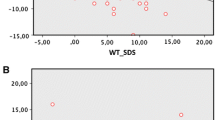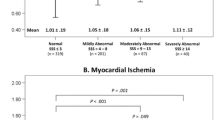Abstract
Objective
To identify the predictive factors of myocardial stunning as assessed by the drop in post-stress Left Ventricular Ejection Fraction (LVEF) in patients with a recent history of myocardial infarction (MI).
Methods
We prospectively included 215 consecutive patients admitted for acute MI who underwent percutaneous coronary intervention with a greater than or equal to grade-3 TIMI flow in the culprit vessel. Six months after discharge, a post-stress/rest 99mTc-sestamibi gated SPECT was performed. The perfusion score was evaluated visually using a 17-segment model. The LVEF drop was considered significant if the post-stress LVEF was ≥5 % below the rest LVEF (QGS® software).
Results
A post-stress LVEF drop was observed in 51 (24 %) patients. Patients with an LVEF drop were more likely than patients with a stable post-stress LVEF to have diabetes (22 % vs. 10 %, p = 0.048), significant ischemia (SDS > 2) (51 % vs. 28 % p = 0.003) and higher rest LVEF [62 % (56–69) vs. 56 % (49–63) p < 0.001]. In contrast, summed rest score, related to infarct size, did not differ between the groups. Multivariate logistic regression analysis identified SDS > 2 (OR 3.78, 95 % CI 1.8–7.92, p < 0.001), diabetes (OR 3.35, 95 % CI 1.33–8.49; p = 0.011) and rest LVEF (OR 1.08, 95 % CI 1.04–1.12, p < 0.001) as independent explanatory variables of an LVEF drop.
Conclusion
In patients with recent MI and post-procedural grade-3 TIMI flow, ischemia and diabetes were independent predictive factors of myocardial stunning. The higher incidence of reversible perfusion abnormalities validates the model of myocardial stunning in the post-MI period, and excludes the potential involvement of myocardial necrosis.


Similar content being viewed by others
Abbreviations
- APMHR:
-
Age-predicted maximal heart rate
- CAD:
-
Coronary artery disease
- CMRI:
-
Cardiac magnetic resonance imaging
- EDV:
-
End-diastolic volume
- ESV:
-
End-systolic volume
- gSPECT:
-
Gated single photon emission computed tomography
- LV:
-
Left ventricle
- LVEF:
-
Left ventricular ejection fraction
- MI:
-
Myocardial infarction
- PCI:
-
Percutaneous coronary intervention
- RICO:
-
obseRvatoire des Infarctus de Côte d’Or
- SDS:
-
Summed difference score
- SRS:
-
Summed rest score
- SSS:
-
Summed stress score
- SEV:
-
Systolic ejection volume
- TIMI:
-
Thrombolysis in myocardial infarction
References
Morishima I, Sone T, Tsuboi H, Mukawa H, Uesugi M, Morikawa S, et al. Risk stratification of patients with prior myocardial infarction and advanced left ventricular dysfunction by gated myocardial perfusion SPECT imaging. J Nucl Cardiol. 2008;15(5):631–7.
Cottin Y, Rezaizadeh K, Touzery C, Barillot I, Zeller M, Prevot S, et al. Long-term prognostic value of 201Tl single-photon emission computed tomographic myocardial perfusion imaging after coronary stenting. Am Heart J. 2001;141(6):999–1006.
Acampa W, Petretta M, Florimonte L, Mattera A, Cuocolo A. Prognostic value of exercise cardiac tomography performed late after percutaneous coronary intervention in symptomatic and symptom-free patients. Am J Cardiol. 2003;91(3):259–63.
Elhendy A, Schinkel AFL, van Domburg RT, Bax JJ, Valkema R, Poldermans D. Prognostic value of stress Tc-99m tetrofosmin SPECT in patients with previous myocardial infarction: impact of scintigraphic extent of coronary artery disease. J Nucl Cardiol. 2004;11(6):704–9.
Sharir T, Germano G, Kavanagh PB, Lai S, Cohen I, Lewin HC, et al. Incremental prognostic value of post-stress left ventricular ejection fraction and volume by gated myocardial perfusion single photon emission computed tomography. Circulation. 1999;100(10):1035–42.
Braunwald E, Kloner RA. The stunned myocardium: prolonged, postischemic ventricular dysfunction. Circulation. 1982;66(6):1146–9.
Toba M, Kumita S-I, Cho K, Ibuki C, Kumazaki T, Takano T. Usefulness of gated myocardial perfusion SPECT imaging soon after exercise to identify postexercise stunning in patients with single-vessel coronary artery disease. J Nucl Cardiol. 2004;11(6):697–703.
Dona M, Massi L, Settimo L, Bartolini M, Giannì G, Pupi A, et al. Prognostic implications of post-stress ejection fraction decrease detected by gated SPECT in the absence of stress-induced perfusion abnormalities. Eur J Nucl Med Mol Imaging. 2011;38(3):485–90.
van ‘t Hof AW, Liem A, Suryapranata H, Hoorntje JC, de Boer MJ, Zijlstra F. Angiographic assessment of myocardial reperfusion in patients treated with primary angioplasty for acute myocardial infarction: myocardial blush grade. Zwolle Myocardial Infarction Study Group. Circulation. 1998;97(23):2302–6.
Fletcher GF, Balady GJ, Amsterdam EA, Chaitman B, Eckel R, Fleg J, et al. Exercise standards for testing and training: a statement for healthcare professionals from the American Heart Association. Circulation. 2001;104(14):1694–740.
American Heart Association Writing Group on Myocardial S, Registration for Cardiac I, Cerqueira MD, Weissman NJ, Dilsizian V, Jacobs AK, et al. Standardized myocardial segmentation and nomenclature for tomographic imaging of the heart. Circulation. 2002;105(4):539–42.
Hachamovitch R, Berman DS, Shaw LJ, Kiat H, Cohen I, Cabico JA, et al. Incremental prognostic value of myocardial perfusion single photon emission computed tomography for the prediction of cardiac death: differential stratification for risk of cardiac death and myocardial infarction. Circulation. 1998;97(6):535–43.
Leslie WD, Tully SA, Yogendran MS, Ward LM, Nour KA, Metge CJ. Prognostic value of automated quantification of 99mTc-sestamibi myocardial perfusion imaging. J Nucl Med. 2005;46(2):204–11.
Verberne HJ, Dijkgraaf MGW, Somsen GA, van Eck-Smit BLF. Stress-related variations in left ventricular function as assessed with gated myocardial perfusion SPECT. J Nucl Cardiol. 2003;10(5):456–63.
Acampa W, Petretta M, Evangelista L, Nappi G, Luongo L, Petretta MP, et al. Stress cardiac single-photon emission computed tomographic imaging late after coronary artery bypass surgery for risk stratification and estimation of time to cardiac events. J Thorac Cardiovasc Surg. 2008;136(1):46–51.
Lipke CSA, Kühl HP, Nowak B, Kaiser H-J, Reinartz P, Koch K-C, et al. Validation of 4D-MSPECT and QGS for quantification of left ventricular volumes and ejection fraction from gated 99mTc-MIBI SPET: comparison with cardiac magnetic resonance imaging. Eur J Nucl Med Mol Imaging. 2004;31(4):482–90.
Ramakrishna G, Miller TD, Hodge DO, O’Connor MK, Gibbons RJ. Differences in left ventricular ejection fraction and volumes measured at rest and poststress by gated sestamibi SPECT. J Nucl Cardiol. 2006;13(5):668–74.
Usui Y, Chikamori T, Nakajima K, Hida S, Yamashina A, Nishimura T. Prognostic value of post-ischemic stunning as assessed by gated myocardial perfusion single-photon emission computed tomography: a subanalysis of the J-ACCESS study. Circ J. 2010;74(8):1591–9.
Fonseca V, Inzucchi SE, Ferrannini E. Redefining the diagnosis of diabetes using glycated hemoglobin. Diabetes Care. 2009;32(7):1344–5.
Johnson LL, Verdesca SA, Aude WY, Xavier RC, Nott LT, Campanella MW, et al. Postischemic stunning can affect left ventricular ejection fraction and regional wall motion on post-stress gated sestamibi tomograms. J Am Coll Cardiol. 1997;30(7):1641–8.
Grozdic I, Sobic-Saranovic D, Pavlovic S, Artiko V, Petrasinovic Z, Jaksic E, et al. Usefulness of gated SPECT myocardial imaging in evaluation of patients with inferior myocardial infarction. Ann Nucl Med. 2011;25(7):494–500.
Sobic-Saranovic DP, Pavlovic SV, Beleslin BD, Petrasinovic ZR, Kozarevic ND, Todorovic-Tirnanic MV, et al. Site of myocardial infarction and severity of perfusion abnormalities impact on post-stress left ventricular function in patients with single-vessel disease: gated single-photon emission computed tomography methoxyisobutylisonitrile study. Nucl Med Commun. 2009;30(2):148–54.
Paul AK, Hasegawa S, Yoshioka J, Tsujimura E, Yamaguchi H, Tokita N, et al. Exercise-induced stunning continues for at least one hour: evaluation with quantitative gated single-photon emission tomography. Eur J Nucl Med. 1999;26(4):410–5.
Bavelaar-Croon CD, America YG, Atsma DE, Dibbets-Schneider P, Zwinderman AH, Stokkel MP, et al. Comparison of left ventricular function at rest and post-stress in patients with myocardial infarction: evaluation with gated SPECT. J Nucl Cardiol. 2001;8(1):10–8.
Mizuno R, Fujimoto S, Saito Y, Nakamura S. Depressed recovery of subendocardial perfusion in persistent heart failure after complete revascularisation in diabetic patients with hibernating myocardium. Heart. 2009;95(10):830–4.
Prasad A, Stone GW, Stuckey TD, Costantini CO, Zimetbaum PJ, McLaughlin M, et al. Impact of diabetes mellitus on myocardial perfusion after primary angioplasty in patients with acute myocardial infarction. J Am Coll Cardiol. 2005;45(4):508–14.
Forrat R, de Lorgeril M, Hadour G, Sebbag L, Delaye J, Ferrera R. Effect of chronic severe diabetes on myocardial stunning in the dog. J Mol Cell Cardiol. 1998;30(9):1889–95.
Isaaz K, Afif Z, Prévot N, Cerisier A, Lamaud M, Richard L, et al. The value of stress single-photon emission computed tomography imaging performed routinely at 6 months in asymptomatic patients for predicting angiographic restenosis after successful direct percutaneous intervention for acute ST elevation myocardial infarction. Coron Artery Dis. 2008;19(2):89–97.
Kroll D, Farah W, McKendall GR, Reinert SE, Johnson LL. Prognostic value of stress-gated Tc-99m sestamibi SPECT after acute myocardial infarction. Am J Cardiol. 2001;87(4):381–6.
Ndrepepa G, Mehilli J, Martinoff S, Schwaiger M, Schömig A, Kastrati A. Evolution of left ventricular ejection fraction and its relationship to infarct size after acute myocardial infarction. J Am Coll Cardiol. 2007;50(2):149–56.
Bodi V, Sanchis J, Lopez-Lereu MP, Nunez J, Sanz R, Palau P, et al. Microvascular perfusion 1 week and 6 months after myocardial infarction by first-pass perfusion cardiovascular magnetic resonance imaging. Heart. 2006;92(12):1801–7.
Timmer JR, Ottervanger JP, Thomas K, Hoorntje JC, de Boer MJ, Suryapranata H, et al. Long-term, cause-specific mortality after myocardial infarction in diabetes. Eur Heart J. 2004;25(11):926–31.
Hambye AS, Vervaet A, Dobbeleir A. Variability of left ventricular ejection fraction and volumes with quantitative gated SPECT: influence of algorithm, pixel size and reconstruction parameters in small and normal-sized hearts. Eur J Nucl Med Mol Imaging. 2004;31(12):1606–13.
Barnett AG, van der Pols JC, Dobson AJ. Regression to the mean: what it is and how to deal with it. Int J Epidemiol. 2005;34(1):215–20.
Ouvrier MJ, Bernard M, Hitzel A, Vera P, Manrique A. Evaluation of exercise-induced myocardial stunning by means of immediate post-exercise Tc-99m sestamibi gated SPECT. Med Nucl. 2009;33(6):331–7.
Higgins JP, Higgins JA, Williams G. Stress-induced abnormalities in myocardial perfusion imaging that are not related to perfusion but are of diagnostic and prognostic importance. Eur J Nucl Med Mol Imaging. 2007;34(4):584–95.
Acknowledgments
We thank Philip Bastable for English assistance and Olivier Hachet for data collection.
Author information
Authors and Affiliations
Corresponding author
Rights and permissions
About this article
Cite this article
Guenancia, C., Cochet, A., Humbert, O. et al. Predictors of post-stress LVEF drop 6 months after reperfused myocardial infarction: a gated myocardial perfusion SPECT study. Ann Nucl Med 27, 112–122 (2013). https://doi.org/10.1007/s12149-012-0661-9
Received:
Accepted:
Published:
Issue Date:
DOI: https://doi.org/10.1007/s12149-012-0661-9




